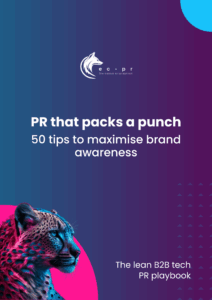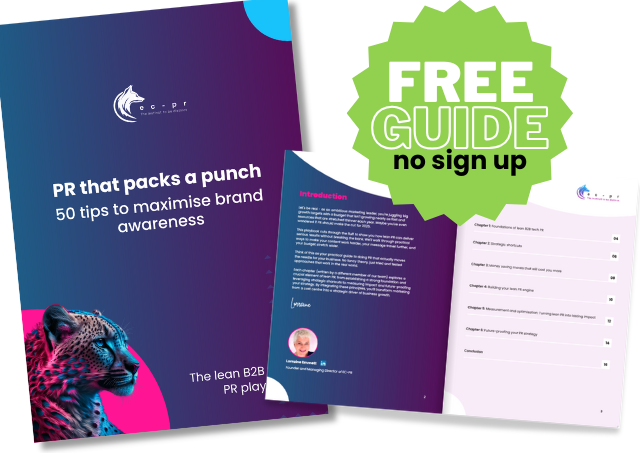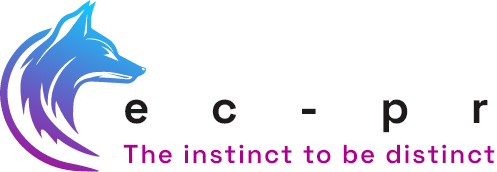
How to amplify your brand awareness on a budget in 2025
A strategic guide for ambitious tech companies to increase their brand awareness on a budget
Brand awareness remains the most misunderstood investment in B2B tech marketing. According to a recent Gartner report, European CMOs have seen an average year-on-year cut their budgets of 15%, despite their reporting that they met and exceeded revenue goals for 2023.
With budgets increasingly limited, building brand awareness has become a critical team sport that can’t be delegated solely to the marketing department. The most successful tech companies recognise that brand building is a collective responsibility, requiring commitment from the C-suite to the newest hire. Whether you’re operating with limited resources or managing a substantial budget, success requires strategic alignment, full organisational commitment, and ruthless prioritisation.
Transform your entire organisation into brand amplifiers
Brand awareness begins with leadership commitment and cascades throughout the organisation. Think of your brand as a story that every employee can tell in their own authentic way. The most effective approach combines clear communication guidelines with systematic employee enablement – start with your communication strategy and you won’t go far wrong.
Your implementation framework should include:
- Creating clear communication guidelines that align with your strategy
- Harnessing senior leaders’ networks through planned thought leadership
- Training team members in effective social sharing and storytelling
- Digital asset templates that ensure brand consistency whilst enabling quick content creation
Remember, your employees’ networks often contain exactly the decision-makers you’re trying to reach. Empowering your team with the right tools and guidelines creates an army of authentic brand advocates who can reach places your corporate channels never will.
When your entire company speaks with a unified voice, your message carries further and lands with greater impact.
Measure success through engagement metrics, share of voice, and lead attribution from employee-shared content. Tribal Impact reported that companies with structured employee advocacy programmes report 79% higher online brand visibility.
2Forge strategic partnerships that matter
Intense competition means going it alone will be increasingly challenging. The most effective companies will build focused partnerships that amplify their message while sharing costs and resources. The key is to be selective – choose partners whose audiences and values align with yours and whose products and services are complimentary.
When building partnerships, focus on:
- Creating co-branded thought leadership content that delivers genuine value and draws on original research
- Launching joint campaigns with clear attribution models
- Regular partnership audits that measure reach, engagement and conversion metrics to ensure ongoing success
A well-chosen partnership can instantly increase brand awareness within your target market and double your reach while halving your costs. But remember, partnership success relies on mutual benefit and consistent engagement. It’s better to have three deep, meaningful partnerships than twenty superficial ones.
3Integrate sales and marketing for authentic storytelling
Your sales team sits on a goldmine of customer insights and real-world success stories. Creating a seamless connection between sales and marketing allows you to turn these insights into compelling real-world stories that resonate with your target audience.
Sales and marketing integration should focus on:
a. Creating feedback loops between sales and marketing to ensure content is relevant and compelling and lead quality is high
b. Creating dynamic content templates that sales teams can customise with real-time insights
c. Regular voice-of-customer sessions with sales teams to inform brand messaging
This alignment ensures your brand messaging reflects customer needs rather than marketing assumptions. It also helps sales teams feel ownership of brand initiatives, making them more likely to share and amplify content.
Transform sales objections into educational content that equips both your target audience and sales team to have more productive conversations about common concerns.
Aim for 40% of marketing content to be directly influenced by sales insights and customer feedback.
Focus resources on high-impact initiatives
In brand building, less is often more. The most successful companies concentrate their resources on fewer, more impactful activities rather than spreading themselves thin. Think of your budget as rocket fuel – it works best when concentrated rather than dispersed. But make sure resource allocation is backed by data-driven insights.
A strategic resource allocation might look like this:
- 50% on proven channels with consistent returns
- 30% on strategic experiments with measured risk
- 20% on maintaining existing brand assets and relationships
Each piece of premium content you create should work hard for its money. That thought leadership report you’re planning, turn it into a podcast, a series of blog posts, social campaigns, webinar content, and sales enablement tools. Make every asset work hard for as long as possible – audio, text and video.
Make sure that your content plan contains a mix of evergreen content and hot topics. Evergreen content can be leveraged for years to come if you implement an audit process for reviewing and updating it regularly.
5Leverage AI while maintaining brand authenticity
AI tools can significantly extend your budget’s reach but need careful management to maintain your unique voice. Think of AI as a powerful but junior team member that needs clear guidelines and consistent oversight.
Your AI utilisation framework should include:
- Detailed brand voice guidelines
- Specific prompts for different content types
- Human editing workflows
- Regular testing against brand standards
Remember, AI is a tool for efficiency, not a replacement for human creativity and strategic thinking. Use it to scale what works, not to replace what makes your brand unique.
Protect your brand integrity through regular AI output audits against your brand guidelines, brand voice checking tools, disclosure for AI-generated content and continuous monitoring of AI regulation compliance.
Building sustainable brand awareness
The most successful tech companies in 2025 will treat brand awareness as a strategic imperative rather than a marketing function. Success requires clear metrics and continuous optimisation:
- Data-driven decision making with clear ROI metrics
- Cross-functional collaboration with defined responsibilities
- Regular testing and optimisation of channels and messages
- Continuous monitoring of emerging platforms and technologies
- Strong frameworks for brand consistency
You should track success through:
- Share of voice in target market segments
- Brand sentiment analysis
- Lead quality metrics
- Customer lifetime value
- Employee advocacy engagement
Most importantly, never lose sight of your primary objective: helping your target customers make informed decisions that solve their challenges.
The tech marketing landscape will continue to change but focusing on these core strategies while maintaining authenticity will help ensure your brand awareness investments deliver measurable returns in 2025 and beyond. Start planning now, measure religiously, and always ask yourself:
“If this were my money, would I spend it this way?”
Cut the fluff! Tech PR that drives serious results

 Download our free guide:
Download our free guide:
PR that packs a punch: 50 tips to maximise brand awareness
Get actionable insights that focus your marketing budget on a public relations approach with proven results!

PR that packs a punch: 50 tips to maximise awareness
Cut through the fluff and learn how PR can deliver serious results without breaking the bank
A free guide - no sign up required.
Our insights
Subscribe to our updates
Stay up to date with the latest insights, case studies and PR guides.

